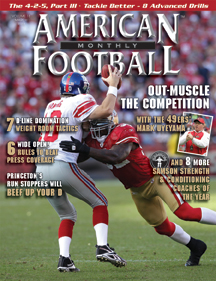Article CategoriesAFM Magazine
|
6 Rules for Beating Press Coverage – Are your receivers getting stuffed by the press? Here’s how to get them freed up.by: Chris MetcalfFormer Wide Receivers Coach, John Carroll High School (AL) © More from this issue One of the most difficult things for my players to do is beat press coverage. Since we run a double wing offense at John Carroll, defenses will often pack the box with defenders and lock down on the outside. By playing press man, defenses try to disrupt the timing of pass routes by jamming receivers at the line of scrimmage. If successful, the defense has a greater opportunity to sack the quarterback since teams often blitz when playing man coverage. However, when a receiver beats press coverage, the result is frequently a big play. We emphasize that failure to convert against press coverage is not an option for us. I teach my receivers to relish the opportunity to prove to the defense that you can beat them 1-on-1 at anytime. We have the attitude that we will beat man coverage whenever the defense presents us with it. This c....The full article can only be seen by subscribers.
|
|
|||||||
| HOME |
MAGAZINE |
SUBSCRIBE | ONLINE COLUMNISTS | COACHING VIDEOS |
Copyright 2025, AmericanFootballMonthly.com
All Rights Reserved





